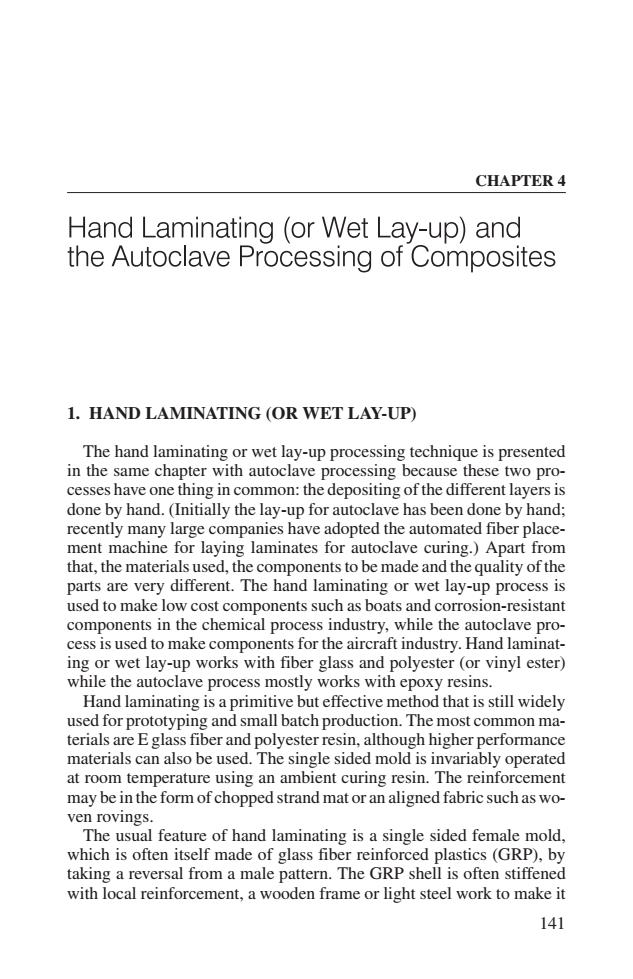正在加载图片...

CHAPTER 4 Hand Laminating (or Wet Lay-up)and the Autoclave Processing of Composites 1.HAND LAMINATING(OR WET LAY-UP) The hand laminating or wet lay-up processing technique is presented in the same chapter with autoclave processing because these two pro- cesses have one thing in common:the depositing of the different layers is done by hand.(Initially the lay-up for autoclave has been done by hand; recently many large companies have adopted the automated fiber place- ment machine for laying laminates for autoclave curing.)Apart from that,the materials used,the components to be made and the quality of the parts are very different.The hand laminating or wet lay-up process is used to make low cost components such as boats and corrosion-resistant components in the chemical process industry,while the autoclave pro- cess is used to make components for the aircraft industry.Hand laminat- ing or wet lay-up works with fiber glass and polyester(or vinyl ester) while the autoclave process mostly works with epoxy resins. Hand laminating is a primitive but effective method that is still widely used for prototyping and small batch production.The most common ma- terials are E glass fiber and polyester resin,although higher performance materials can also be used.The single sided mold is invariably operated at room temperature using an ambient curing resin.The reinforcement may be in the form of chopped strand mat or an aligned fabric such as wo- ven rovings. The usual feature of hand laminating is a single sided female mold, which is often itself made of glass fiber reinforced plastics(GRP),by taking a reversal from a male pattern.The GRP shell is often stiffened with local reinforcement,a wooden frame or light steel work to make it 141CHAPTER 4 1. HAND LAMINATING (OR WET LAY-UP) The hand laminating or wet lay-up processing technique is presented in the same chapter with autoclave processing because these two processes have one thing in common: the depositing of the different layers is done by hand. (Initially the lay-up for autoclave has been done by hand; recently many large companies have adopted the automated fiber placement machine for laying laminates for autoclave curing.) Apart from that, the materials used, the components to be made and the quality of the parts are very different. The hand laminating or wet lay-up process is used to make low cost components such as boats and corrosion-resistant components in the chemical process industry, while the autoclave process is used to make components for the aircraft industry. Hand laminating or wet lay-up works with fiber glass and polyester (or vinyl ester) while the autoclave process mostly works with epoxy resins. Hand laminating is a primitive but effective method that is still widely used for prototyping and small batch production. The most common materials are E glass fiber and polyester resin, although higher performance materials can also be used. The single sided mold is invariably operated at room temperature using an ambient curing resin. The reinforcement may be in the form of chopped strand mat or an aligned fabric such as woven rovings. The usual feature of hand laminating is a single sided female mold, which is often itself made of glass fiber reinforced plastics (GRP), by taking a reversal from a male pattern. The GRP shell is often stiffened with local reinforcement, a wooden frame or light steel work to make it 141